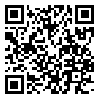دوره 22، شماره 3 - ( 7-1404 )
جلد 22 شماره 3 صفحات 51-46 |
برگشت به فهرست نسخه ها
Download citation:
BibTeX | RIS | EndNote | Medlars | ProCite | Reference Manager | RefWorks
Send citation to:



BibTeX | RIS | EndNote | Medlars | ProCite | Reference Manager | RefWorks
Send citation to:
Roostaei F, Radmehr M, Mohammady M, Sadeghi N. The effects of maternally administered neonate massage on feeding tolerance and physiological indicators in neonates admitted to the neonatal intensive care unit: A Randomized Controlled Trial. J Res Dev Nurs Midw 2025; 22 (3) :46-51
URL: http://nmj.goums.ac.ir/article-1-1977-fa.html
URL: http://nmj.goums.ac.ir/article-1-1977-fa.html
The effects of maternally administered neonate massage on feeding tolerance and physiological indicators in neonates admitted to the neonatal intensive care unit: A Randomized Controlled Trial. Journal of Research Development in Nursing and Midwifery. 1404; 22 (3) :46-51
چکیده: (475 مشاهده)
Background: Feeding intolerance, defined as the inability to maintain enteral feeding, is frequently observed in neonates with immature gastrointestinal tracts in neonatal intensive care units (NICUs). This study aimed to examine the effects of maternally administered infant massage on feeding tolerance and physiological indicators in NICU-admitted neonates.
Methods: This single-blind, parallel-group randomized controlled trial was conducted among neonates admitted to the NICU of a university-affiliated tertiary neonatal and pediatric center in Isfahan, Iran. Using simple random allocation via card shuffling, 62 neonates meeting the inclusion criteria were divided into two groups: intervention and control. The intervention group received maternally administered massage for five days, three times daily for 20 minutes after feeding with breast or formula milk. The control group received routine care. Assessed outcomes were gastric residual volume, abdominal circumference, frequency of vomiting and stools, and physiological indicators checklist, which measured respiratory rate, heart rate, and oxygen saturation (SaO₂) levels two hours after each feeding every day for five days. Data were analyzed using the Mann–Whitney U test, Wilcoxon signed-rank test, and ANCOVA in SPSS v.26, with a significance level of p < 0.05.
Results: Neonates in the intervention group showed a greater reduction in gastric residual volume % (r² = 0.82, 95% CI [0.75, 0.88]), abdominal circumference (r = 0.82, 95% CI [0.68, 0.97]), and vomiting frequency (r = 0.83, 95% CI [0.69, 0.97]) compared to the control group. Additionally, stool frequency increased significantly in the intervention group (r = 0.85, 95% CI [0.73, 0.99]). In this group, SaO₂ levels increased (r = 0.82, 95% CI [0.68, 0.97]), while heart rate (r = 0.83, 95% CI [0.69, 0.97]) and respiratory rate (r = 0.85, 95% CI [0.73, 0.99]) decreased significantly, indicating improved physiological stability.
Conclusion: Maternally administered infant massage appeared effective in improving feeding tolerance and physiological indicators in this study. Healthcare teams may also consider training mothers to provide neonate massage as a complementary intervention to support feeding tolerance in newborns admitted to the NICU.
Methods: This single-blind, parallel-group randomized controlled trial was conducted among neonates admitted to the NICU of a university-affiliated tertiary neonatal and pediatric center in Isfahan, Iran. Using simple random allocation via card shuffling, 62 neonates meeting the inclusion criteria were divided into two groups: intervention and control. The intervention group received maternally administered massage for five days, three times daily for 20 minutes after feeding with breast or formula milk. The control group received routine care. Assessed outcomes were gastric residual volume, abdominal circumference, frequency of vomiting and stools, and physiological indicators checklist, which measured respiratory rate, heart rate, and oxygen saturation (SaO₂) levels two hours after each feeding every day for five days. Data were analyzed using the Mann–Whitney U test, Wilcoxon signed-rank test, and ANCOVA in SPSS v.26, with a significance level of p < 0.05.
Results: Neonates in the intervention group showed a greater reduction in gastric residual volume % (r² = 0.82, 95% CI [0.75, 0.88]), abdominal circumference (r = 0.82, 95% CI [0.68, 0.97]), and vomiting frequency (r = 0.83, 95% CI [0.69, 0.97]) compared to the control group. Additionally, stool frequency increased significantly in the intervention group (r = 0.85, 95% CI [0.73, 0.99]). In this group, SaO₂ levels increased (r = 0.82, 95% CI [0.68, 0.97]), while heart rate (r = 0.83, 95% CI [0.69, 0.97]) and respiratory rate (r = 0.85, 95% CI [0.73, 0.99]) decreased significantly, indicating improved physiological stability.
Conclusion: Maternally administered infant massage appeared effective in improving feeding tolerance and physiological indicators in this study. Healthcare teams may also consider training mothers to provide neonate massage as a complementary intervention to support feeding tolerance in newborns admitted to the NICU.
| بازنشر اطلاعات | |
 |
این مقاله تحت شرایط Creative Commons Attribution-NonCommercial 4.0 International License قابل بازنشر است. |




